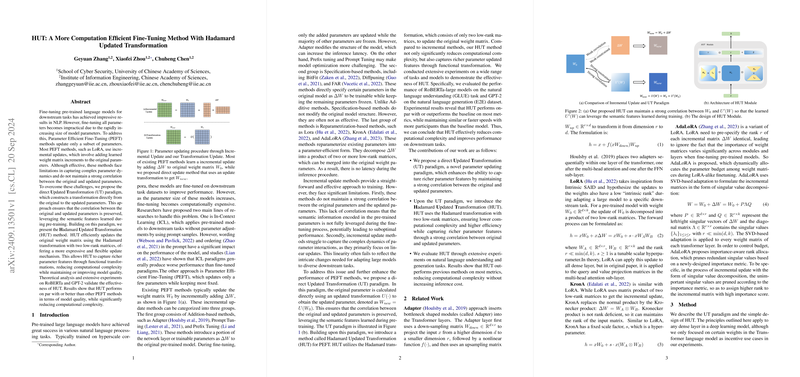HUT: A More Computation Efficient Fine-Tuning Method With Hadamard Updated Transformation
The paper "HUT: A More Computation Efficient Fine-Tuning Method With Hadamard Updated Transformation" presents a methodological advancement in Parameter Efficient Fine-Tuning (PEFT) techniques for pre-trained LLMs, specifically addressing the computational inefficiencies inherent in fine-tuning large-scale models. The authors propose an innovative framework called the direct Updated Transformation (UT) paradigm and introduce the Hadamard Updated Transformation (HUT) method based on this paradigm.
Background and Motivation
Fine-tuning pre-trained LLMs on specific downstream tasks has become a standard approach in NLP. However, the increasing parameter sizes of these models render full fine-tuning computationally expensive and impractical. PEFT methods have emerged as a viable solution by tuning only a subset of parameters while keeping the majority fixed. Existing PEFT techniques, like LoRA and its derivatives, rely primarily on incremental updates—adding learned weight matrix increments to the original model parameters. Although effective, these incremental updates face limitations in capturing complex parameter dynamics and maintaining correlation between the original and updated parameters.
Methodological Innovation
The direct Updated Transformation (UT) paradigm proposed in this paper seeks to address these limitations. Unlike prior methods that add an increment , UT constructs a transformation directly from original parameters to updated parameters . This paradigm ensures that the correlation between original and updated parameters is preserved, allowing the model to leverage the semantic features learned during pre-training.
Building on the UT paradigm, the Hadamard Updated Transformation (HUT) method employs the Hadamard product to update the original weight matrix using two low-rank matrices. The HUT method offers a more expressive and flexible update mechanism, capturing richer parameter features through functional transformations while significantly reducing computational complexity compared to incremental methods.
Experimental Validation
Theoretical analysis and empirical evaluations validate the efficacy of HUT. The authors conduct extensive experiments using the RoBERTa-large and GPT-2 models across various natural language understanding (GLUE benchmark) and generation (E2E NLG Challenge) tasks.
Results on GLUE Benchmark
The experimental results on the GLUE benchmark demonstrate the effectiveness of HUT in natural language understanding tasks. HUT achieved state-of-the-art performance on four of the six datasets and the highest average score across all datasets. Notably, on the CoLA dataset, HUT showed a performance improvement of 2.3% over the previous best-performing model, LoRA. The average score improvement across all datasets was 0.6% compared to FourierFT.
Computational Efficiency
In terms of computational efficiency, HUT significantly reduces the number of floating-point operations (FLOPs) compared to other PEFT methods. The method also does not introduce any additional inference latency, making it a highly efficient approach for fine-tuning large models.
Results on E2E NLG Challenge
When applied to the GPT-2 model for the E2E NLG Challenge, HUT again outperformed several other PEFT methods, including LoRA and full fine-tuning, on multiple evaluation metrics. This confirms that HUT's ability to capture parameter update features extends to natural language generation tasks as well.
Implications and Future Directions
The contribution of the HUT method lies in its ability to maintain a strong correlation between the pre-trained and updated parameters, leveraging pre-existing semantic richness. This alignment not only enhances model performance but also achieves computational efficiency, addressing a significant barrier in fine-tuning large-scale models.
Future research could explore additional transformations within the UT paradigm, broadening the applicability and effectiveness of parameter-efficient fine-tuning methods. Additionally, examining the theoretical underpinnings of why certain transformations perform better could yield deeper insights into fine-tuning dynamics.
Conclusion
In summary, the HUT method represents a notable advancement in the domain of parameter-efficient fine-tuning for large pre-trained LLMs. By introducing the direct Updated Transformation paradigm and leveraging the Hadamard product, the authors offer a solution that achieves state-of-the-art performance while significantly reducing computational requirements. This work demonstrates that efficient and effective fine-tuning is feasible, opening pathways for more scalable and adaptable NLP models in practical applications.
